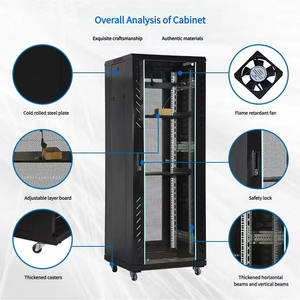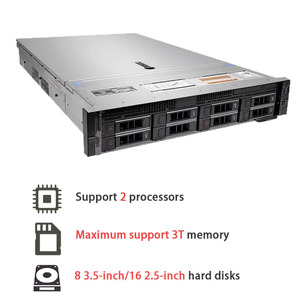
All categories
Featured selections
Trade Assurance
Buyer Central
Help Center
Get the app
Become a supplier

(4632 products available)



























A web server is a piece of hardware or software that handles HTTP requests. Its job is to send requested information to the web client. When thinking about a web server, many people think of the server as a physical server computer. At the same time, a web hosting service provider is a company that owns many servers and hosts websites on web servers. There are two main types of web servers: Apache and Nginx. Apache web servers are the most commonly used, accounting for 25% of websites. The next in line is Nginx, which accounts for 13% of website usage.
Both servers are open-source but have slight differences that may appeal to some businesses more than others. For example, while Apache can run on various operating systems, including Unix, Linux, Windows, and Netware, Nginx can only run on Unix-like systems. Nginx uses an event-driven architecture, which enables it to handle many requests simultaneously while utilizing less memory within the computer system. On the flip side, Apache employs a process-driven method that creates separate processes or threads for each connection, consuming more of the server's resources.
Businesses must weigh the pros and cons of each type of web server before deciding. Generally, Apache is preferable if a company runs its site on Windows. However, a business using a Unix server may benefit more from Nginx. Companies may want to consider the complexity of dynamic tasks before making a choice. While Nginx is faster at serving dynamic content, Apache can handle more complex dynamic tasks because it supports various modules. Price is another factor businesses must consider. Although both types of web servers are free, companies will have to spend more money on a support system for anything outside of self-support.
When it comes to types of web servers, it is helpful to categorize them based on the functions they perform after determining whether they are hardware or software. For example, gateway and proxy web servers function differently even though they fall under the same umbrella. A gateway web server is where client requests first arrive, while a proxy web server is both a server and a client that makes requests on behalf of another to the internet. Reverse proxy and load balancing web servers route requests to different servers to balance traffic. All these web servers have different roles, but part of their job is to optimize performance and enhance security by managing requests.
Communication Protocol:
The Hypertext Transfer Protocol (HTTP) is the primary protocol web servers use to communicate with clients. It has many different versions, including HTTP/1.1, which includes request methods like GET, POST, and PUT as well as status codes like 404 (Not Found) and 500 (Internal Server Error). HTTP/2, on the other hand, supports multiplexing and header compression to improve performance. Web servers also use HTTPS, the secure version of HTTP, which employs Transport Layer Security (TLS) to encrypt communications and safeguard the privacy of users.
The File Transfer Protocol (FTP) is another well-known communication protocol that web servers use. FTP is frequently used to upload and download files from web servers. While FTP uses two separate TCP connections for data transfer and control, FTP.Sec and FTPS both add support for TLS/SSL to encrypt the credentials and the data being transferred.
Server-Side Technologies
Web servers frequently employ server-side technologies to deliver dynamic content and interactive services. Server-side scripting languages like PHP, Python, Ruby, and Node.js are commonly used to produce dynamic content by processing requests and retrieving data from databases. To create interactive web apps, use Express.js with Node.js, Django with Python, Ruby on Rails with Ruby, or Laravel with PHP.
Web Server Features
Web servers come with a variety of features that improve their functionality and performance. Load balancing, virtual hosting, caching, SSL/TLS support, authentication and authorization, URL rewriting, logging and monitoring, Gzip compression, support for different web sockets, and other protocols are some of the most notable features.
Web servers direct incoming requests to different servers or server instances to distribute the load evenly among them. This ensures high availability and reliability. Servers can host multiple websites or applications using the same IP address or server resources by differentiating requests based on domain names or URLs. By temporarily storing copies of frequently accessed resources, web servers can improve response times and reduce bandwidth usage.
Web Server Applications
A web server is a powerful, customizable tool for serving content over the internet or intranet thanks to its wide range of functions and capabilities. Some of its most common applications include hosting websites, serving web applications, and providing APIs and microservices, among others.
Web server hardware is used to store, process, and deliver webpages to clients. It is a fundamental component of the global internet. However, web server applications can be used for much more than just hosting websites. Some other general applications of a server include:
Besides the general applications of a server, specific industries rely on web servers to carry out their day-to-day operations. Here are some industries and examples of how they use web servers:
Finding the most suitable server requires determining the server's purpose, platform, and operating system, among other things.
Q1: What are the different types of web servers?
A1: The most popular (but not the only) web server software are: Apache, Nginx, Microsoft Internet Information Services (IIS) - for Windows servers, LiteSpeed - known for its performance, Caddy - known for its automatic HTTPS, Tomcat - for Java applications.
Q2: What are the functions of a web server?
A2: A web server's main function is to serve web pages, but it can also serve other content, such as images, videos, downloads, email, or applications.
Q3: How does a web server work?
A3: When a web browser requests a page, the web server checks if it's available. If it is, the server sends back the page so the browser can see it. This all happens very fast.
Q4: What is the difference between web server and application server?
A4: A web server serves static web content stored on the server, like HTML files. In contrast, an application server web server handles dynamic content generated by running applications. An application server offers more services to business applications than a web server. Sinohb.com